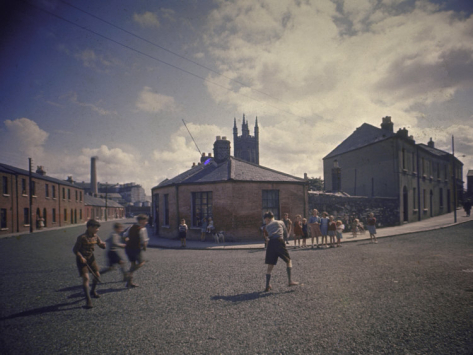“I thought that no man liveth and dieth to himself, so I put behind what I thought and what I did , the panorama of the world I lived in- the things that made me.” Sean O’Casey (1948)
This year marks the 50th anniversary of the death of Sean O’Casey in 1964 . O’Casey spent many years of his life living locally , first at 25 Hawthorn Terrace and afterwards at 18 Abercorn Road. These were important years which helped shape O’Casey as a man, and would provide him with the inspiration ( the characters , language and attitudes) that would reappear in his writing throughout his life.
Between 1939 and 1955 he published six volumes of Autobiography. The first three in particular contain much about his life as a North Dock resident. Throughout this anniversary year , we intend to present short extracts from these works , concentrating on sections which are most relevant to the area . These are written in the third person-’ Johnny Cassidy’ is O’Casey – and the names of people and places are often spelt slightly askew! We start with a short piece , in which’ Johnny ‘ , at home in Abercorn Road gets bored with study and lets his mind drift , considering the surrounding landscape and the historic ‘Battle of Clontarf’ which occurred nine centuries earlier .
“It was a wintry night. The room was bitterly cold, and dismally dark, too, save where a yellowish trickle of timorous light crept through the window from a gas-lamp on the edge of the pavement outside, so long a swing-swong for the children that it had now bent forward over the street, looking like an old man who had lighted a light in the hope of finding a lost piece of silver. On the little old table , now the colour of dull ebony , Johnny had been silently and insistently learning more of grammar , geography and of history , by the smoky ray of a tiny oil-lamp, flickering every other second, making the words dance before his eyes, as if they were alive and wanted to escape from his boring stare. “
“He paused at the window, and looked out at the naked night. A thin, sour, sharp-faced sickle of a moon tried to peer out of a cloudy wind-tossed sky, looking like a maid peeved with a wind that sullied her neatness. Over beyond the canal toward the ugly bloated spire of the catholic church, a tapering finger on a fat hand beckoning to the ships that came sailing into the Bay of Dublin. The saint after whom the church was called had gone out alone to meet the clanging Normans when they came trotting on to take Dublin back to their hairy bosoms; the saint asking when his nose got the smell of the steel in the line of their glances, Is it peace, my dear Christian brothers, is it peace ? And they had answered sweetly, saying, It’s bloody wars unless you and your cross-brained viking Tooles give way , give wisely, give all. And the saint had bowed, saying , All that we have is thine. Then the iron- skinned warriors stroked their beards , murmuring, It is well. So in the midst of their lances, shields , and battle-axes, the saint rode back in triumph , the people cheering because of his valour in bringing peace and poverty to them.
Nearer than the thick-bellied steeple gleamed the rosy red lights of the railway signals, looking like fiery red buttons on the dark-blue coat of our lady of the night , with the sickle moon a dull gold curb in her night-blown hair.
Every other moment from the shunting yard came the clanging crash of heavy goods wagons striking each other as the shunters harried them from line to line; or , sometimes, a succession of clangs was heard when a running rake of wagons came into sharp collision with another rake so that the two might be made into one.
All round where Johnny was looking, ah, many ,many years ago , the Danes and the Irish grappled together in their last fierce fight ; the last long fight between darkness and light. Here the black-browed Thor went down before the gentle, gold-headed Jesus. Here the white and pearly dove pecked out the eyes and clawed out the guts of the vengeful and vindictive raven. Here the sign of the Hammer shrivelled up in the sign of the cross ; and the darkness and fury fled before sweetness and light . Here the skirl of the Christian war-pipe shrilled at the bellowing of the heathen horns, helped by the lapping drone of the sea as his waves came curling in from Dublin Bay. The Danish Dubliners watched from their Woden walls the armies hacking and slashing and slaying and thrusting each other through till the number of heads floating on the waters and lying on the land seemed like a bloody fall of hailstones. “
“He must stop his dusky dreaming , and go back to the glow of his work. But he still lingered at the window , looking out at a world of a few dark shapes, the pompous steeple , the red lights of the railway, the yellow pool of light given by the gas-lamp on the edge of the sidewalk , and the slender , ogling slip of a moon , peering slantwise from the gloomy clouds , like a sly wanton eyeing a timid man from behind a curtain.”
Extracts from “Pictures in the Hallway” (1942)
All six volumes of Sean O’Casey Autobiographies, republished by Faber and Faber , are currently available in both print and kindle editions.
If you have a favourite Sean O’Casey extract please bring it to our attention .
Contact us at eastwallforall@gmail.com




